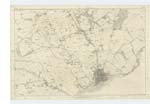OS1/14/80/37
| List of names as written | Various modes of spelling | Authorities for spelling | Situation | Description remarks |
|---|---|---|---|---|
| ST VIGEAN'S CHAPEL (Remains of) | St Vigeans Chapel (Remains of) | Rev [Reverend] John Muir Mr Brown |
046 | [Situation] East side of Grange of Conon These vestiges are said to be the remains of the original St Vigean's Chapel, which was used as a place of worship, previous to the erection of the one which is now the Parish Church. Mr Brown an Antiquary in Arbroath states that this Chapel must have been built between the ninth and tenth Century. About the year 1790 human bones were found within the inclosure where the remains of the chapel are situated. |
| Site of GRAVE YARD [St Vigean's Chapel] | 046 | About the year 1790 human bones were found within the inclosure where the remains of the chapel are situated. It appears there was a graveyard attached as Mr. Bremnar of Arbroath and others say there were great quantities of human bones dug up near the chapel from time to time. |
Continued entries/extra info
[Page] 37Parish of St Vigeans -- Plan 46 No.1 Trace 4
St. Vigean's Chapel [note]
St Vigean was a monk and famed preacher in the "
end of the tenth century. His original Chapel and hermitage
were at Grange of Conan where there are a small grove
and foundations of a Chapel, and also a most copious
fountain, which preserves his name. Three or four acres
of land contiguous to these are by tradition held as belonging
to the Chapel. Not far from this place, there was a baronial
Castle named + Gory or Gregory which perhaps afforded
protection to him; and a + Druidical Circle, on another
eminence not very distant, laid a foundation for the rude
population conveniently assembling and being converted to a new faith by former local association"
New Stat. Acct. [Statistical Account] of Forfarshire. pp. [pages] 489, 490
+ Enquiry has been concerning "Castle Gregory" and also concerning the "Druidical Circle" mentioned
above, among the persons consulted were the Revd. [Reverend] Mr Muir ph. [parish] minister Mr. Bremnar of Arbroath, & Mr
Miller, Writer, of the latter place, but they all express their opinion that the site of either of these
objects has not been known to any one of the present generation although it is traditionally stated that Colliston
House was built of the stones found in the ruins of Castle Gregory.
Transcribers who have contributed to this page.
Alison James- Moderator, KBMW- Moderator
Location information for this page.
Linked mapsheets.




